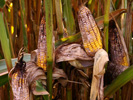Schmale, D.G., and G.P. Munkvold. 2009. Mycotoxins in Crops. The Plant Health Instructor. DOI: 10.1094/PHI-I-2009-0715-01. Reviewed 2014.
David G. Schmale III
Virginia Polytechnic Institute and State University, Blacksburg, VA
Gary P. Munkvold
Iowa State University, Ames, IA
INTRODUCTION
 |
|
Figure 1
|
 |
| Figure 2 |
Mycotoxins are chemicals produced by fungi that are harmful to humans and domestic animals. These chemicals may contaminate staple foods and feeds worldwide, posing a number of significant food safety concerns [Figure 1]. Mycotoxins may be fatal or cause severe illness at very small concentrations, often measured in parts per million (ppm) or parts per billion (ppb). There may be thousands of mycotoxins on the planet earth, but only a small fraction of these toxic chemicals have the potential to cause plant and animal diseases. In nature, mycotoxins may act to disable host defense responses or to defend the fungus against other microorganisms.
The study of mycotoxins, known as mycotoxicology, began in 1960 on a farm in England [Figure 2]. Over 100,000 young turkeys died from 'Turkey-X disease' after eating a peanut meal that was contaminated with aflatoxins—a then new group of mycotoxins produced by the fungus Aspergillus flavus. In the years since this massive fatality, other important mycotoxins including ergot alkaloids, fumonisins, ochratoxins, trichothecenes, and zearalenone have been discovered and described, many the result of other devastating intoxications.
This lesson provides an overview of economically important mycotoxins that may contaminate livestock feed or human staple foods and threaten the health of humans and domestic animals [Table 1]. Other mycotoxins not shown in Table 1 (e.g., citrinin, cyclopiazonic acid, and patulin) also can be economically important at times. For a more comprehensive review including additional mycotoxins, a good reference is the publication by CAST (2003).
The specific aims of this lesson are to:
- Introduce the major groups of mycotoxins, the fungi that produce them, and the crops in which these mycotoxins are most frequently associated,
- Present important diseases of humans and domestic animals caused by mycotoxins (known as mycotoxicoses),
- Consider strategies to mitigate mycotoxin contamination in agricultural systems,
- Present current technologies for the detection of mycotoxin contamination, and
- Discuss the global impact of mycotoxins with a particular emphasis on third world countries.
ACKNOWLEDGMENTS
The authors are grateful to the members of the Mycotoxicology Committee of the American Phytopathological Society for ideas and other input that contributed to the development of this lesson.
|
Table 1. Summary of the major classes of mycotoxins, the common food products that may be contaminated with mycotoxins, and the animals that are most affected. |
|
Mycotoxin |
Contaminated products |
Animals affected |
Clinical effects |
|
Aflatoxins |
Corn, peanuts, cottonseed, tree nuts, dairy products |
Swine, dogs, cats, cattle, sheep, young birds, humans |
Liver damage, intestinal bleeding, cancer |
|
Ergot alkaloids |
Rye, sorghum, pasture grasses |
Cattle, sheep, humans |
Hallucinations, gangrene, loss of limbs, hastening of birth |
|
Fumonisins |
Corn, silage |
Horses, swine, humans |
Pulmonary edema, leukoencephalomalacia, esophageal cancer, neural tube defects, liver damage, reduced growth |
|
Ochratoxins |
Cereal grains, coffee, grapes |
Swine, humans |
Kidney and liver damage, cancer |
|
Trichothecenes |
Wheat, barley, oats, corn |
Swine, dairy cattle, poultry, horses, humans |
Feed refusal, diarrhea, vomiting, skin disorders, reduced growth |
|
Zearalenone |
Corn, hay |
Swine, dairy cattle |
Enlargement of uterus, abortion, malformation of testicles and ovaries |
Next: Aflatoxins
